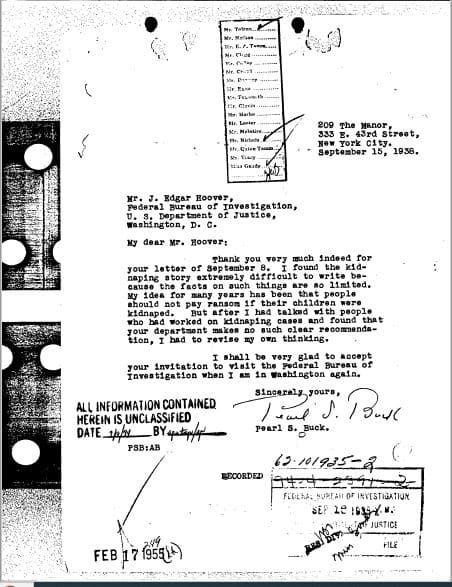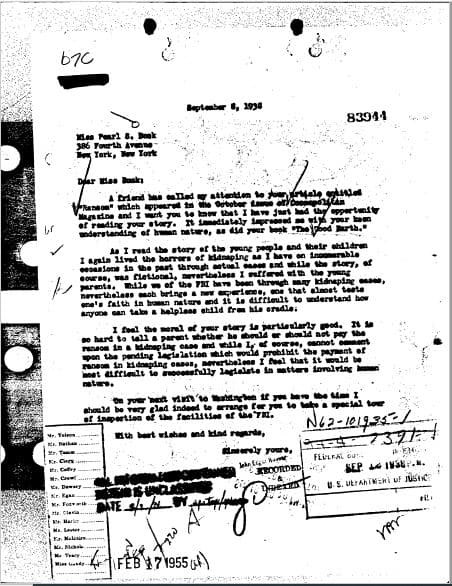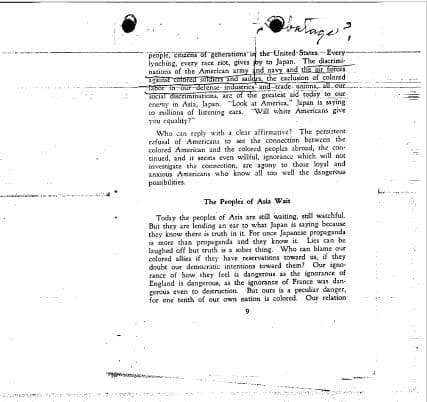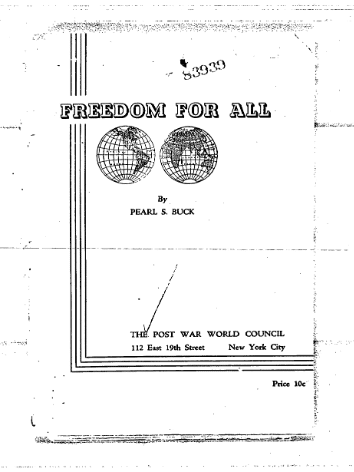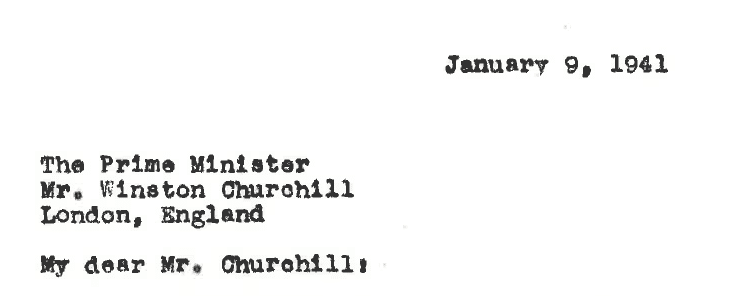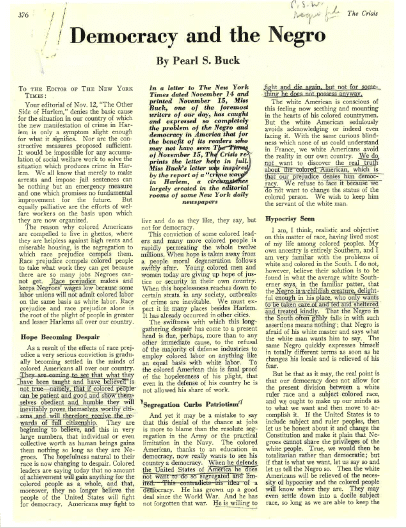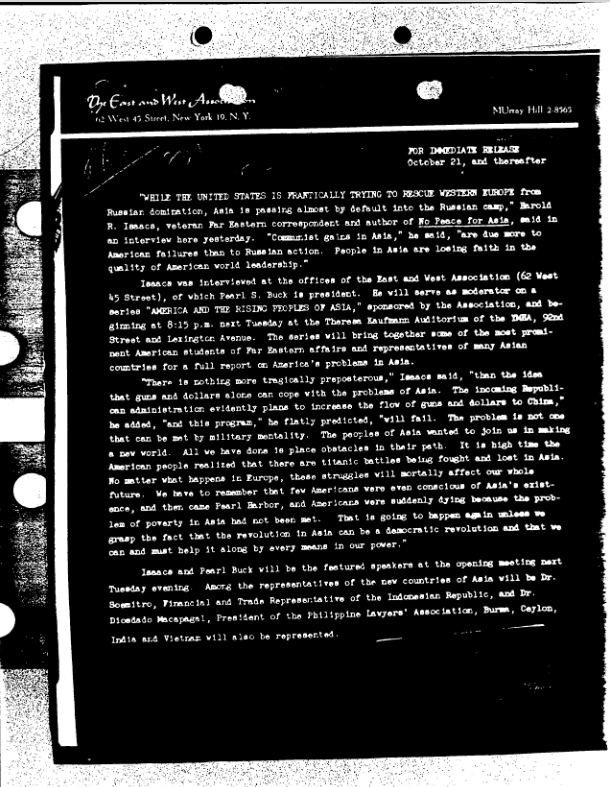
The journey through the FBI file starts in 1938.
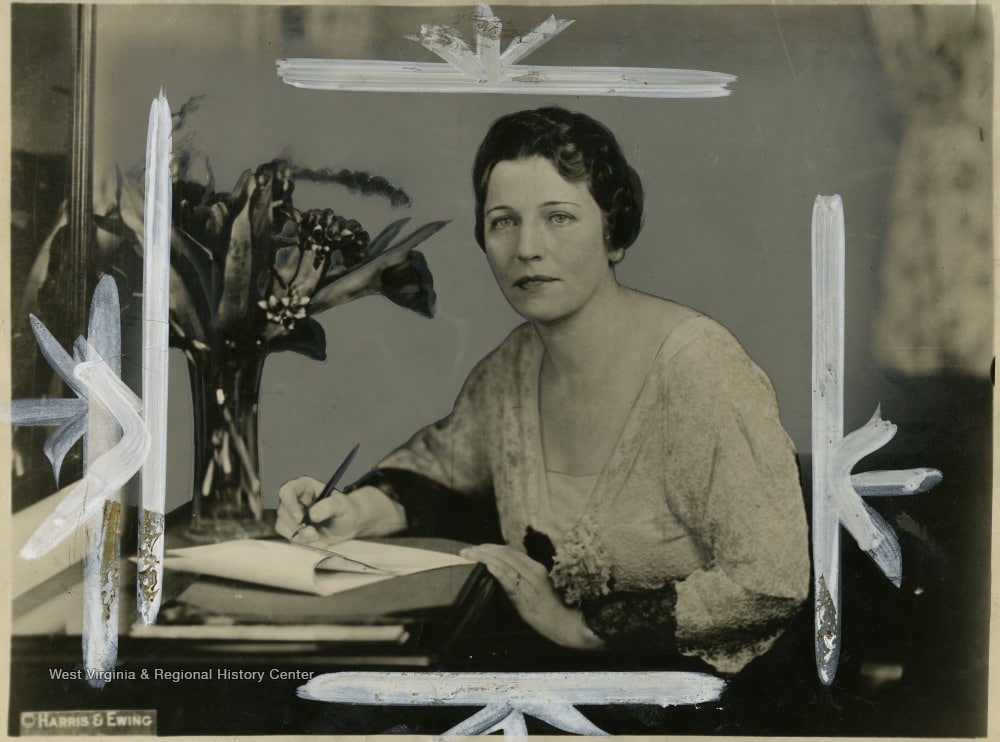
“We’re a lawless people. If we made a law against paying ransoms, nobody would obey it anymore than they did Prohibition. No, when Americans don’t like the law, they break it. And so we still have kidnappers. It’s the price we pay for a democracy. Yes it was the price everybody paid.”
- Abridged from "Ransom"
In early September 1938, Pearl S. Buck received a letter from the freshly named Federal Bureau of Investigation Director J. Edgar Hoover. He wrote not about her many accomplishments or increasing global recognition, but about her short story, “Ransom,” from the October 1937 issue of Cosmopolitan Magazine.
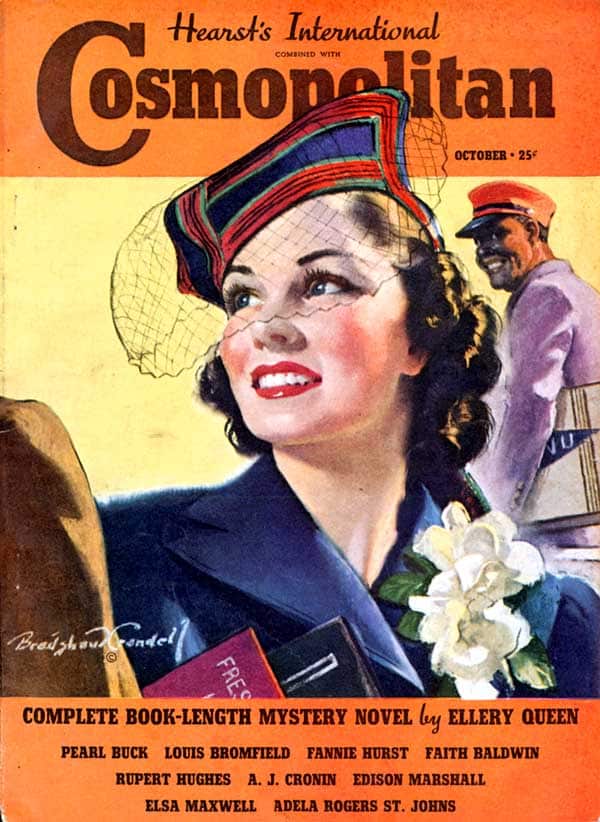

“[The Story] immediately impressed me with your keen understanding of human nature, as did your book, The Good Earth…As I read the story of the young people and their children, I again lived the horrors of kidnapping as I have on innumerable occasions in the past through actual cases and while the story, of course, was fictional, nevertheless I suffered with the young parents…[Each new kidnapping] case brings a new experience, one that almost tests one’s faith in human nature…I feel the moral of your story is particularly good.”
- J. Edgar Hoover
These two letters below make up the first documents in a multi-volume case file. Hoover’s letter offers a remarkable gesture from one who made his fame in part by bringing the kidnapper of the Lindbergh baby to justice in 1932. Hoover’s respect for Pearl Buck’s work employs the same premise upon which he would later base and authorize several more updates of the case file on a less friendly basis. The power of literature to persuade and provoke the public is precisely what brought Ms. Buck to the attention of the FBI.
Wartime
During World War II the FBI Book Review Unit gathered files on authors such as Langston Hughes, Ernest Hemingway, W.E.B. Dubois, Pearl S. Buck and many others. To Director Hoover, writers were particularly concerning since they made a living by thinking and speaking their minds. As a prominent writer and outspoken activist, Ms. Buck fulfilled two important criteria for suspicious persons under FBI policy.
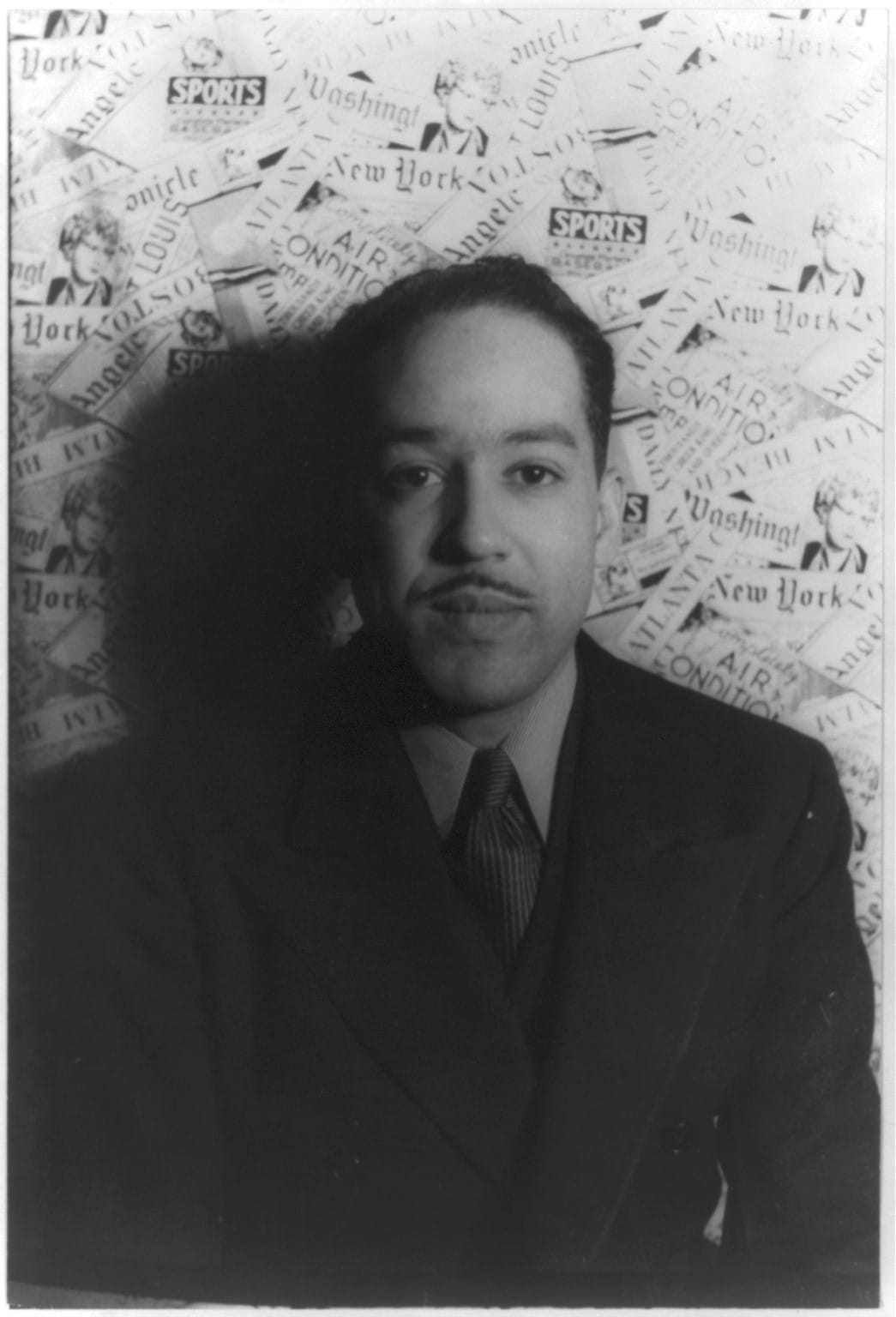
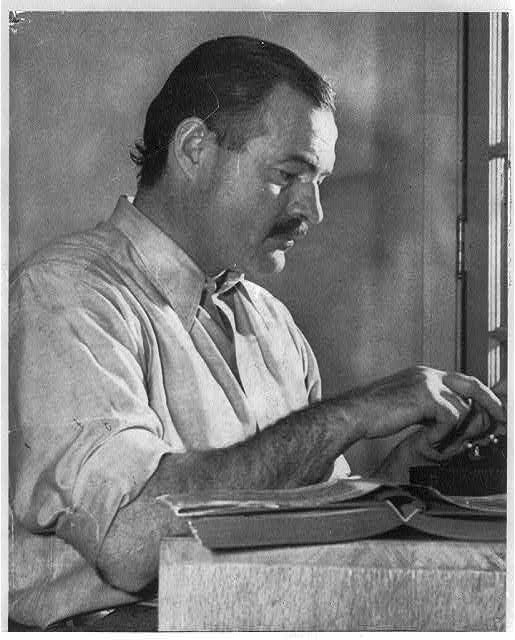
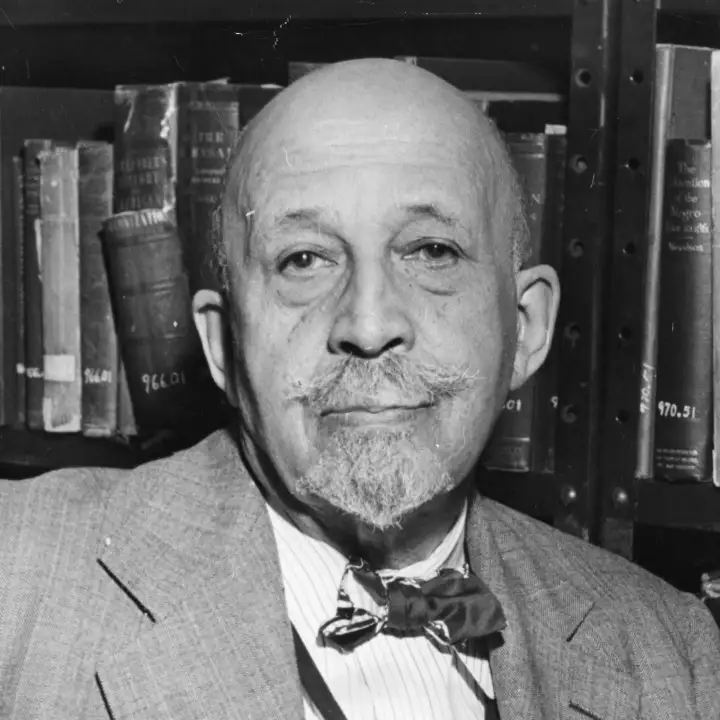
Wartime was very busy for Pearl Buck. She served as Vice Chairman of the National Committee of the American Civil Liberties Union (ACLU) (1943-1954), Chairman of the Committee Against Race Discrimination in the War Effort (1943-1951), and supported a great variety of causes and organizations that the FBI considered to be Communist front groups. Throughout the war years, the FBI collected articles, mail, and publications by Ms. Buck to create a personal profile of her life. Suspected connections to the Communist Party and statements of perceived sedition are chronicled in the file.
In 1941, the Bureau received a pamphlet entitled “Freedom for All” from a citizen informant. This was written by Pearl Buck for the Post War World Council, an organization in New York that advocated for racial justice and democracy.

“The discriminations of the American army and navy and the air forces against colored soldiers and sailors, the exclusion of colored labor in our defense industries and trade unions, all our social discriminations, are of the greatest aid today to our enemy in Asia, Japan.”
“[After the Second World War ended, colonialism would also have to end, because] the deep patience of colored peoples is at an end.”
Click the photo at left to read the page.
Continuing throughout the file are letters, newspaper clippings, pamphlets, and other documents that detail the organizations of concern that Pearl Buck was affiliated with. The one word that ties them all together is the Bureau's all-encompassing term for something suspicious, Security Matter C, or communism.
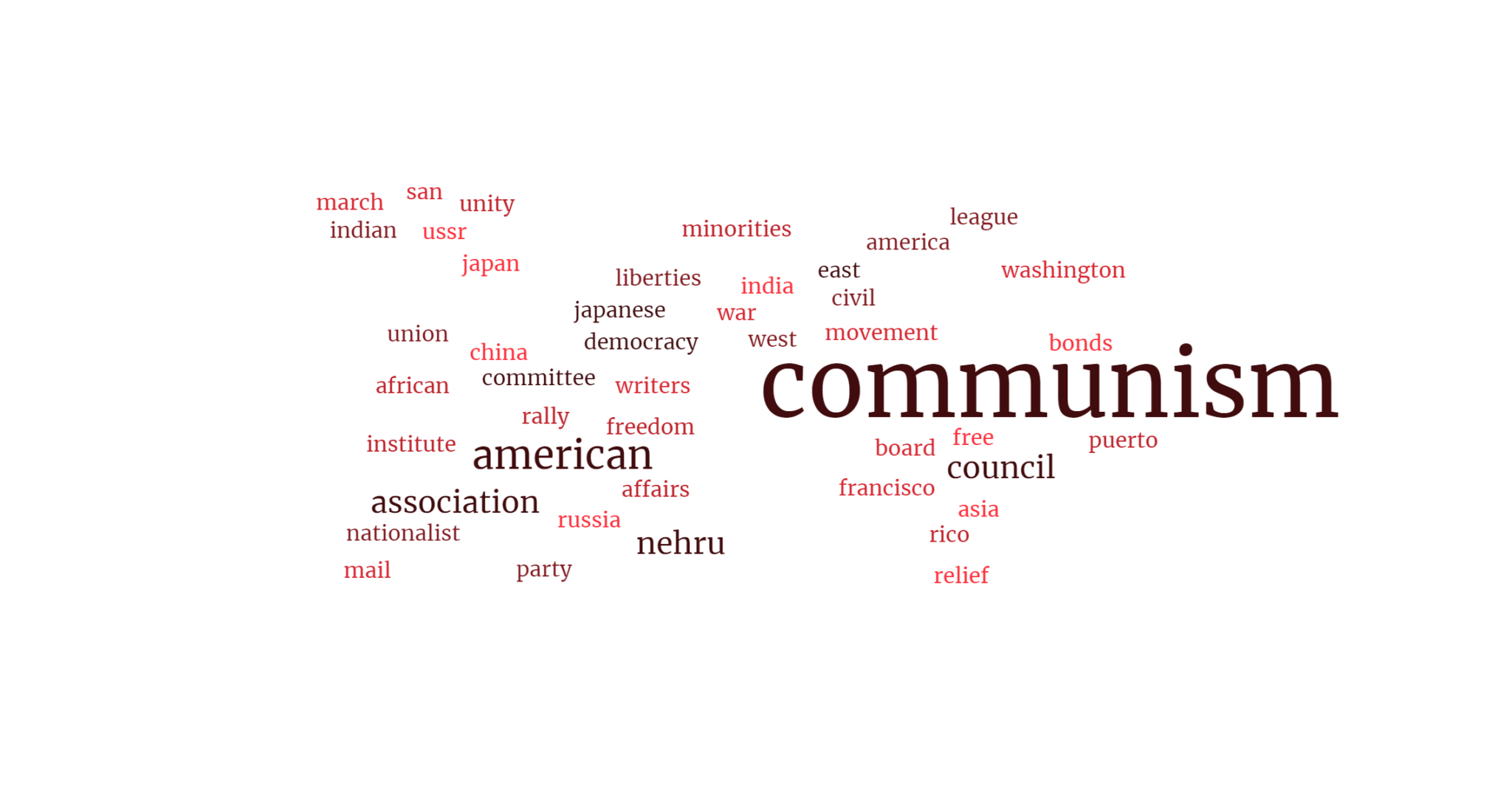
“While no information has been received which would indicate that Pearl S. Buck is either a member of the Communist Party or is controlled by the Communists, she has through her militant activity in furtherance of all programs designed to secure equality for the colored races associated herself with many known Communists and other individuals of varying shades of political opinions."
-FBI Office Memorandum, United States Government March 21, 1946, to Director J. Edgar Hoover, from D.M. Ladd, Assistant to the Director
Organizations/Activity of Concern:
- Japanese American Committee for Democracy
- East and West Association
- The American Civil Liberties Union
- Indian League of America
- Association with Nationalist Party of Puerto Rico
- Council on African Affairs
- Institute on Minorities
- Council for American Unity
- Freedom Rally at San Francisco
- The Writers’ War Board
- The march on Washington Movement
- Mail from the USSR
- Writings on Racial Equality
Pearl Buck’s opinions on military segregation, race relations, her relief work for China, and her outspoken condemnation of Great Britain’s rule over India brought her even more Bureau attention.
Humanitarian Aid for China
In 1937, the Second Sino-Japanese War began. A highly sought after “prize” for the Japanese, China was highly coveted due to it being twenty-five times the size of Japan and home to one-fifth of the world’s people. Pearl Buck recognized the need for aid to China. She and her husband Richard Walsh created the China Emergency Relief Committee with the goal of raising $1 million in six months for humanitarian aid. The goal was met.
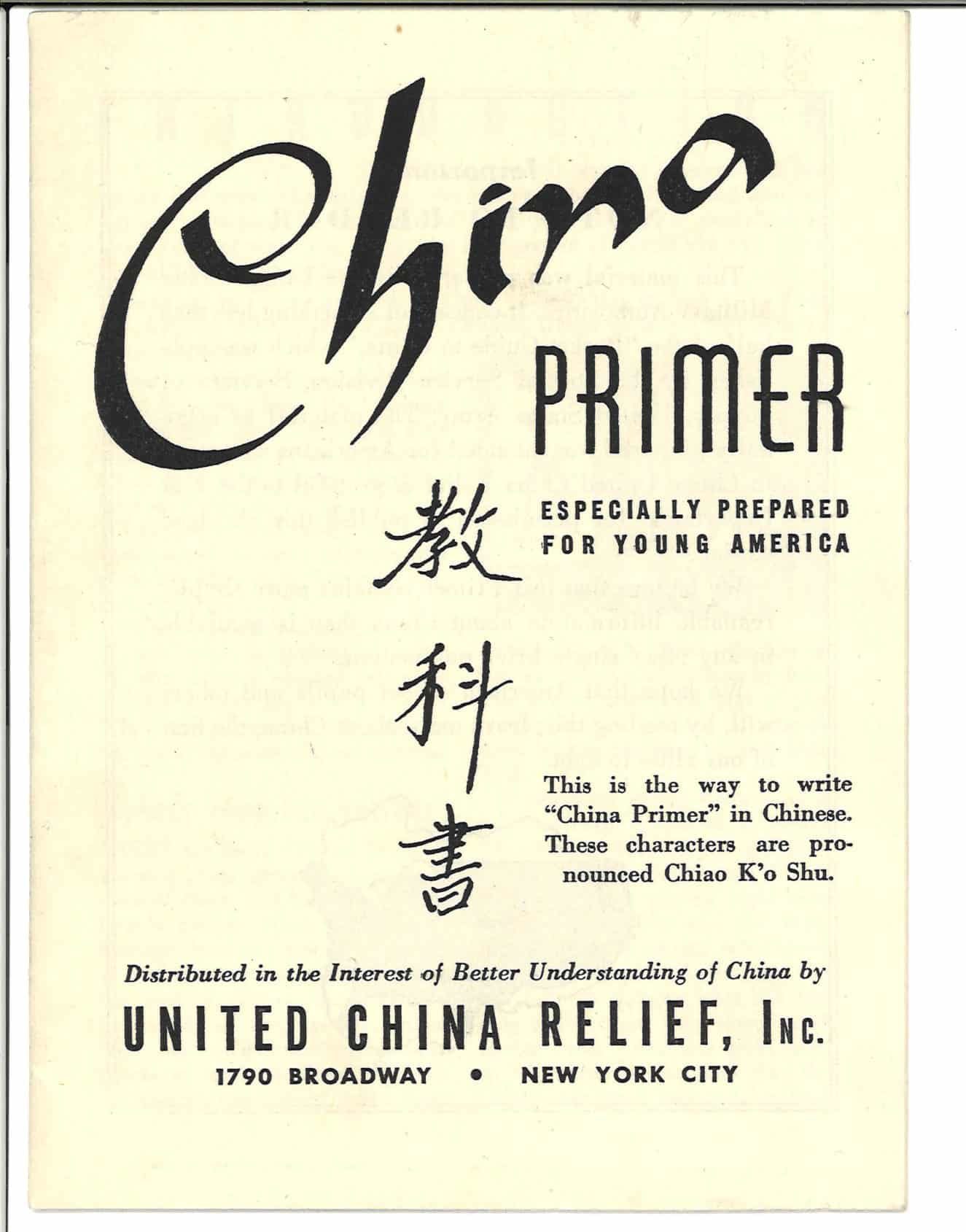
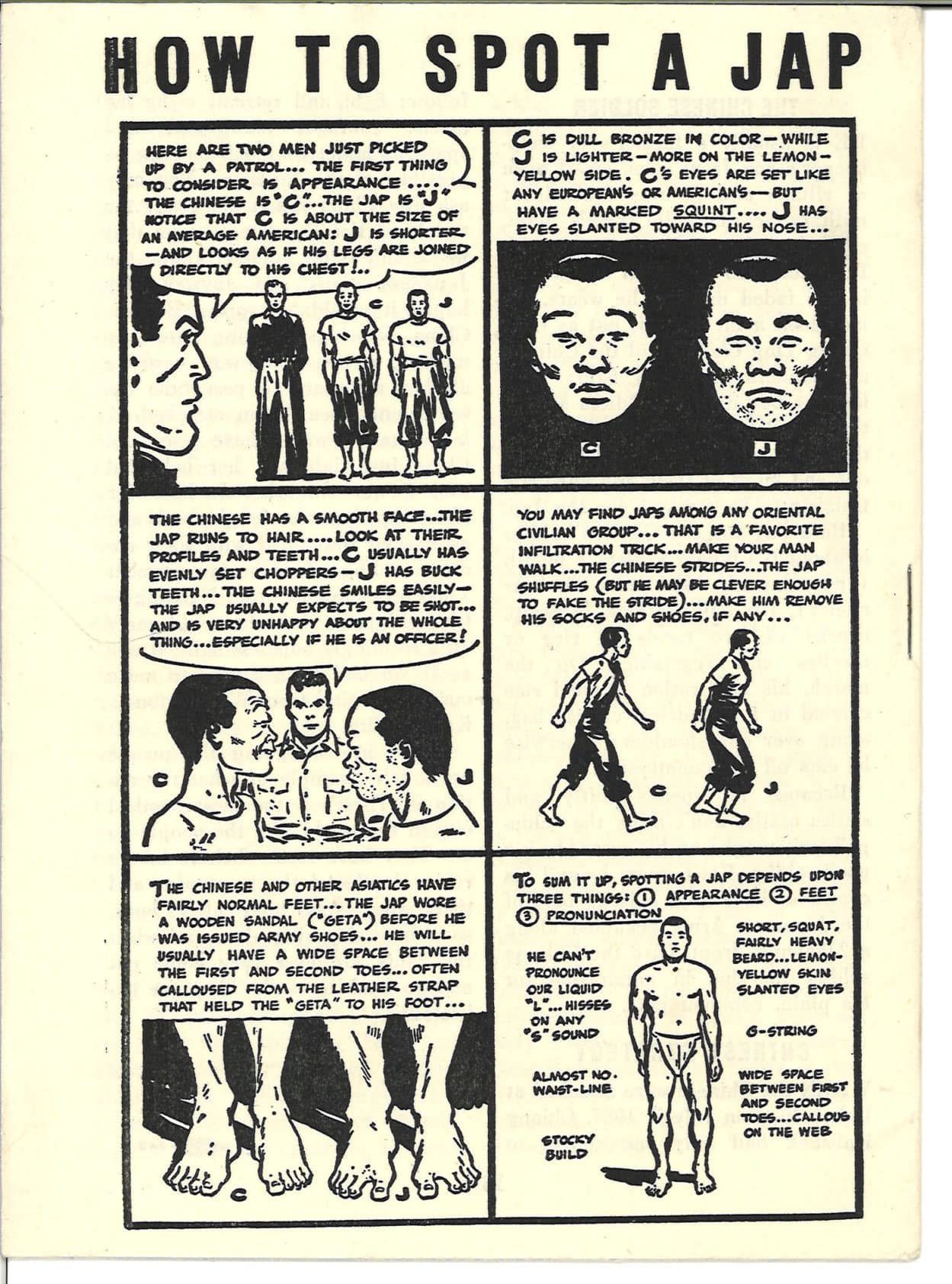
This booklet was distributed to help Americans learn about Chinese people and how they were different from the Japanese.
At right is an image of Wendell L. Willkie, director of United China Relief, and Pearl S. Buck with a poster to be used in a drive for $5,000,000 for Chinese Relief. In the background is a portrait of Mme. Chiang Kai-Shek, wife of the leader of China from 1928-1975.
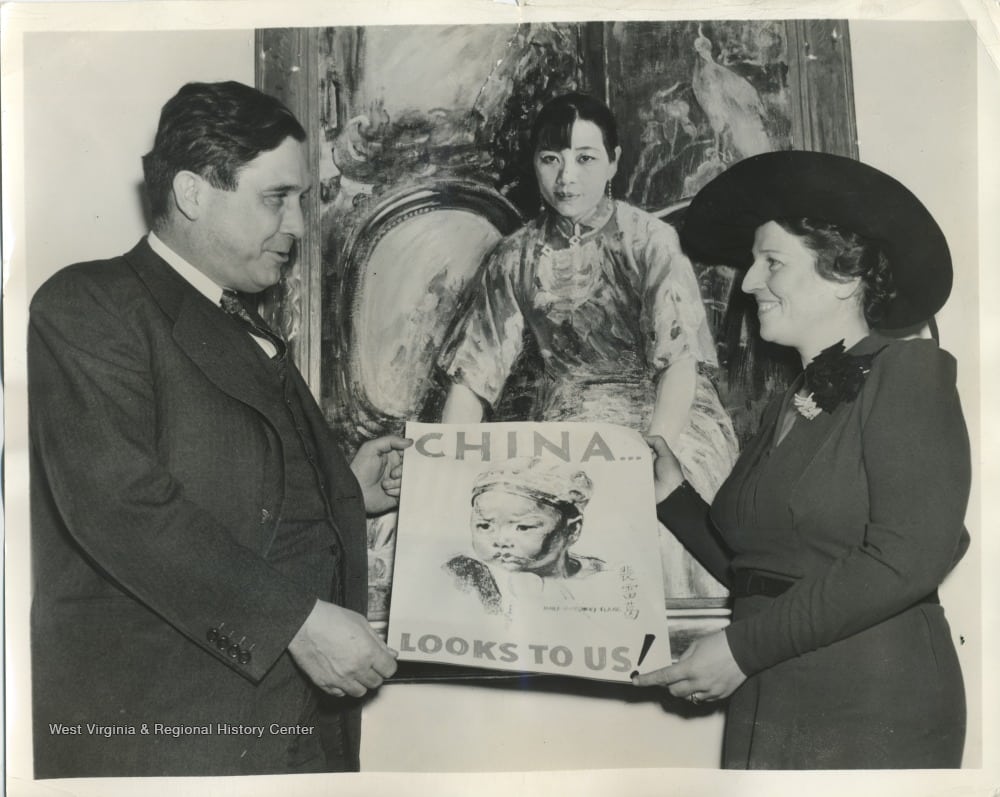
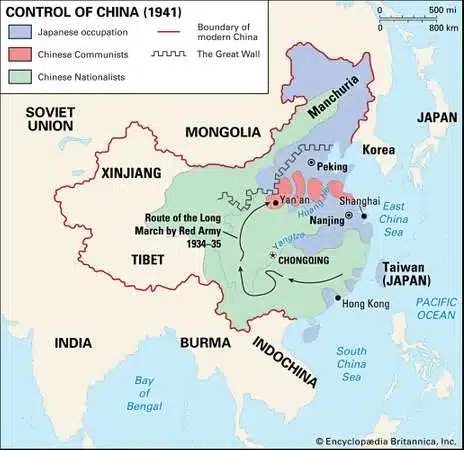
By late 1941, the Japanese controlled part of eastern China from Manchuria to Shanghai, major port cities.
By the time America declared war on Japan at the end of the year, about 100 million Chinese people were living as prisoners of war in their own homeland. In 1942, Pearl Buck published Dragon Seed, a fictional response to the war tragedies inflicted upon the rural Chinese population. The book sold over a quarter of a million copies and was made into a film in 1944, starring Katherine Hepburn.
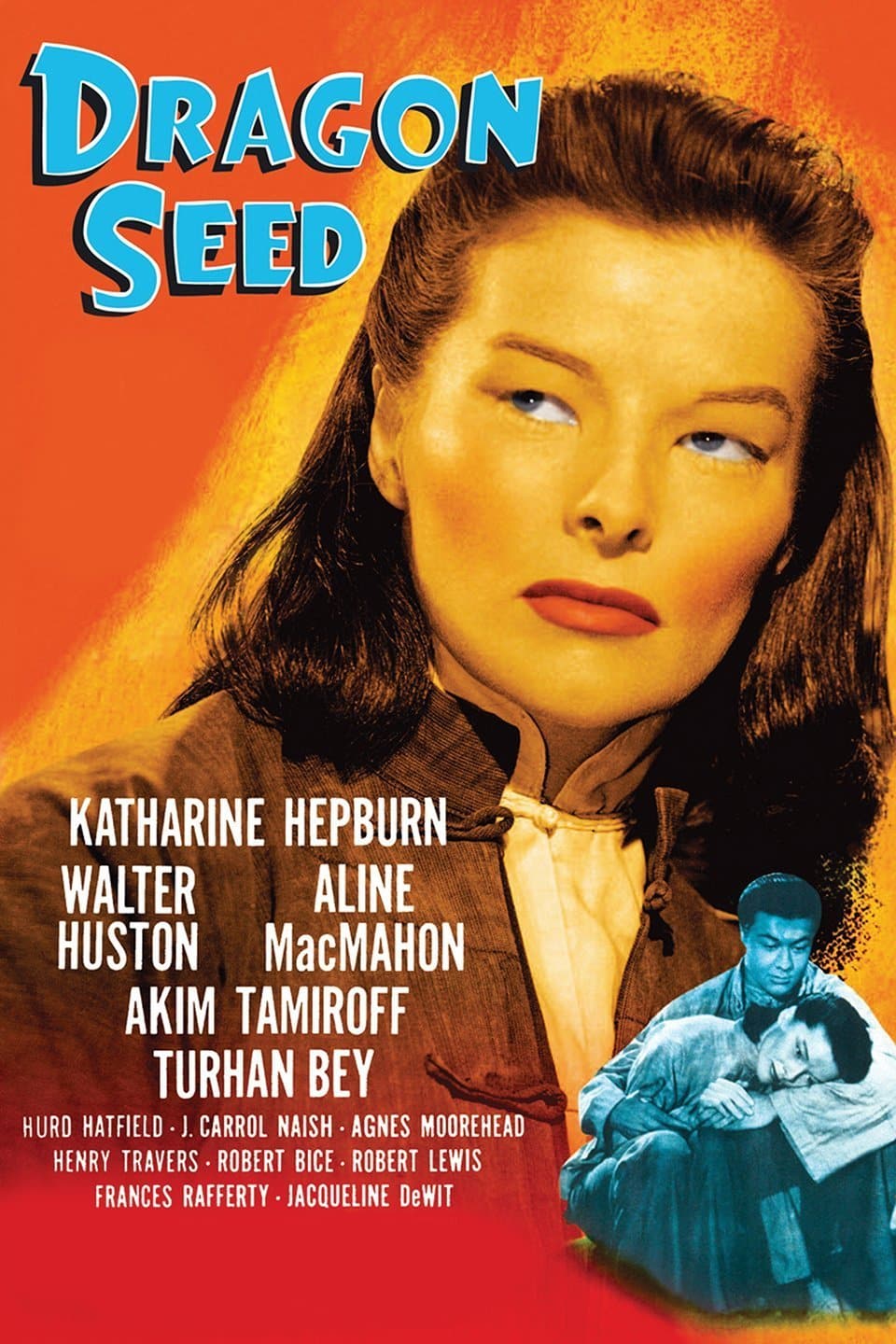
In 1945, at the end of the war, millions of Chinese people died from disease and starvation under the Japanese military regime.
Indian Independence
Pearl Buck was an Honorary President of the Indian League of America. In August of 1944 a Special Agent interviewed a confidential Informant about the propaganda being spread by the group. Their sole purpose was to spread propaganda concerning the harsh imperialistic treatment of the peoples of India by Great Britain. The FBI was also concerned that the group was anti-ally and therefore un-American in sentiment. This concern was deepened when the group praised the Soviet Union for offering to help establish a free India after the war. Ms. Buck was documented as stating that, “the League would play an important part in postwar activities by giving support to Soviet Union ideology.”
In January of 1941, Pearl Buck wrote a letter to the Prime Minister of Great Britain, Winston Churchill. Her aim was to ask why India had not been granted their independence. In her view, if Great Britain ended imperialism in India during the war that would, “hearten the cause of democracy.”
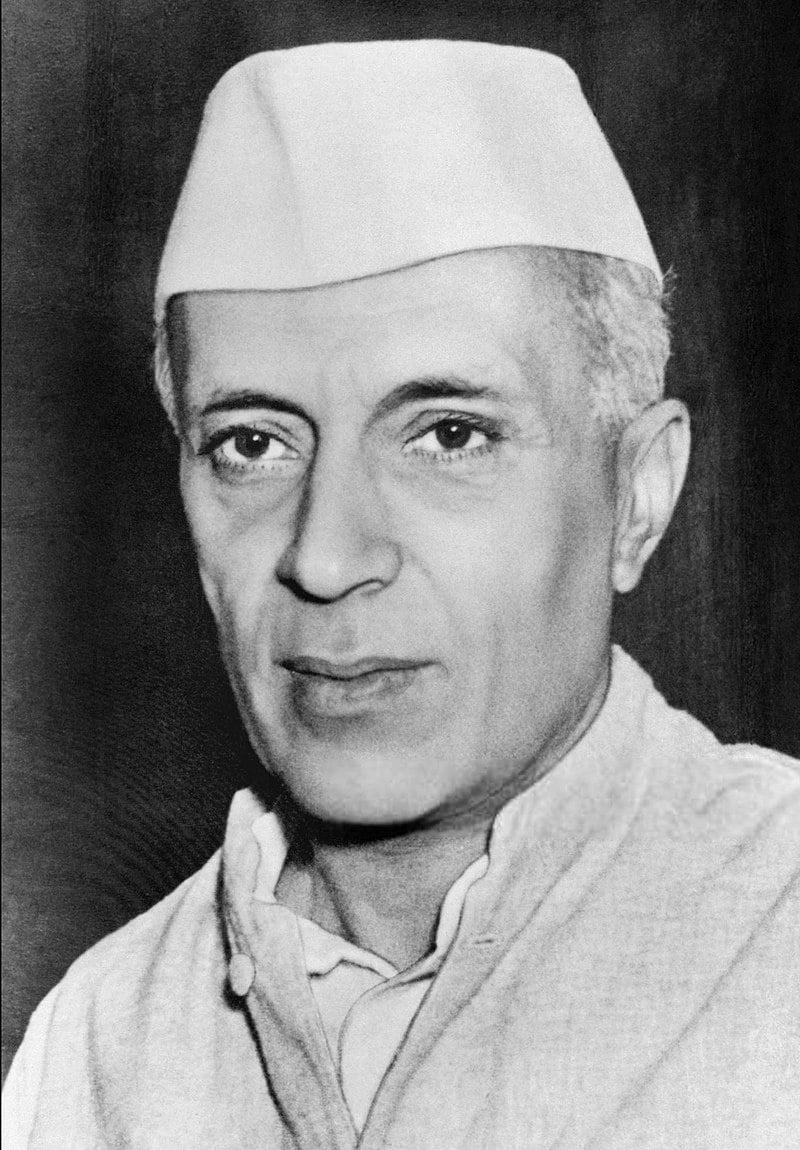
“…why does England at this strategic time put such a man as Jawaharlal Nehru in jail in India? Why is India not given colonial liberty.”
“If you in England would stand for liberty for India, and if the President in this country would stand for equality to the Negro here, the cause for democracy would flame into reality for millions who now doubt its worth and work for it with only half their hearts.”
Click below to read Pearl Buck's full letter and the response from 10 Downing Street.
Opinions on Race Relations
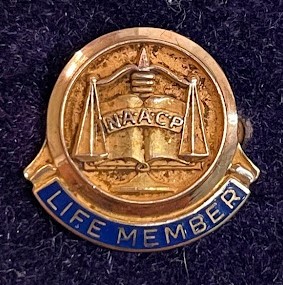
Pearl S. Buck was a life member of the NAACP and wrote for their publication The Crisis on numerous occasions.
In response to a New York Times article from Nov. 12, 1941 titled “The Other Side of Harlem,” Pearl Buck wrote to the editor in which she “expressed so completely the problem of the Negro and democracy in America.” The letter was published in full in the December 1941 issue of The Crisis.
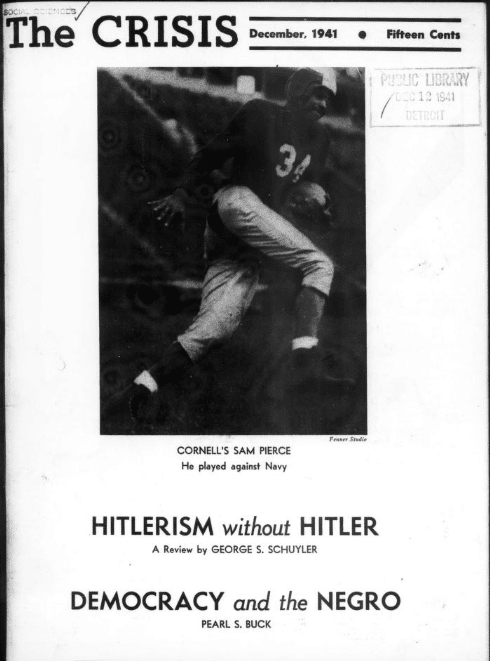
In her letter, Pearl wrote about....
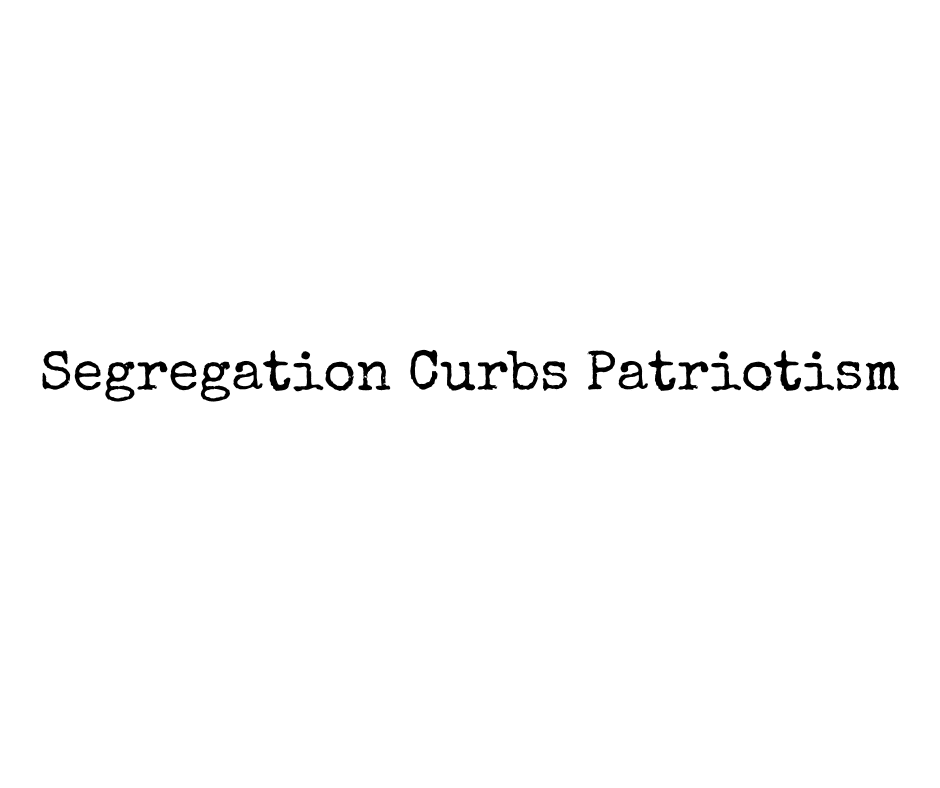

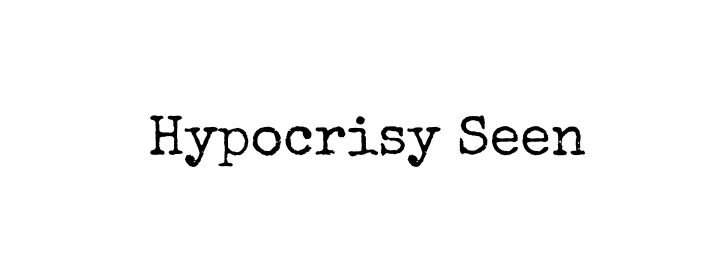
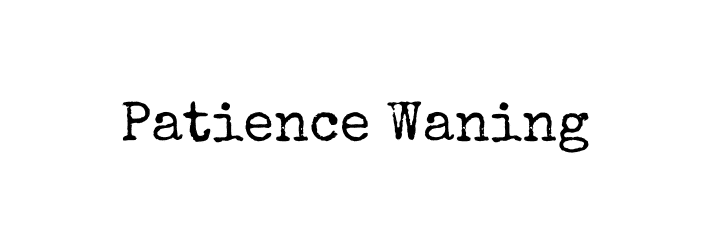


“Is democracy right or is it wrong? If it is right, then let us dare to make it true.” - Pearl S. Buck
Read "Democracy and the Negro" in its entirety by clicking on the image at right
As president of the East and West Association Pearl Buck and her husband Richard J. Walsh sought to establish and promote a better understanding between the peoples of the East and West through means of literature, radio programs, lectures, and motion pictures. This included distribution of Russian literature. This memo from the East and West Association was copied into her FBI file.
Johnny Everyman
The publication of Johnny Everyman, a DC Comic superhero character in the 1940s, was examined and deemed suspicious within the FBI file. This series of comics was produced by the East and West Association and the Editorial Advisory Board of DC Comics with the purpose of promoting understanding between peoples of the world. The Bureau received no information that the comic strip was Communist propaganda, but feared it was the type of material the Communist Party would use and capitalize on if possible.
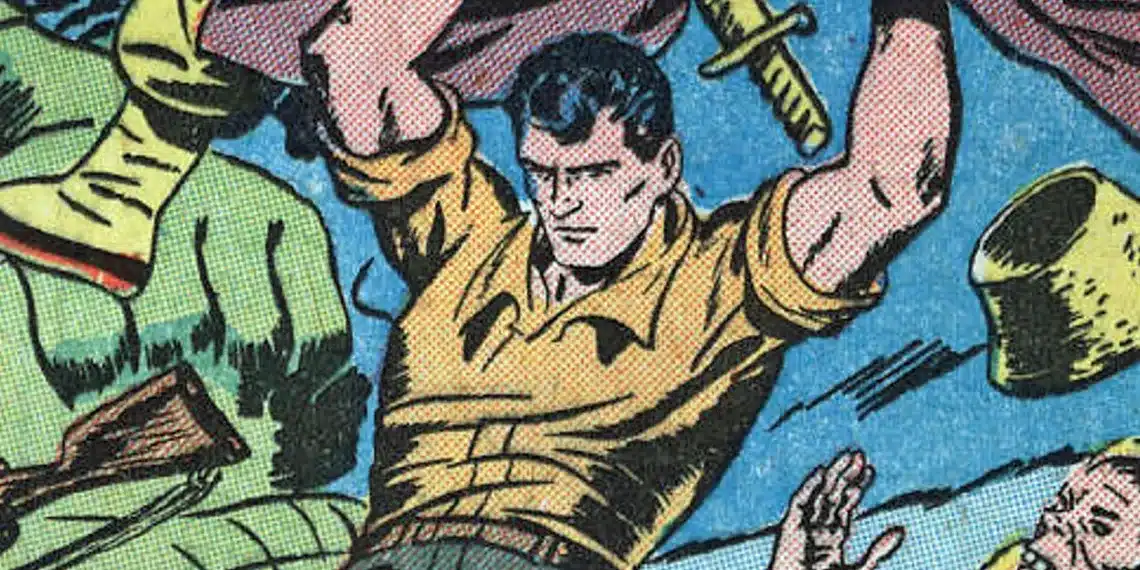
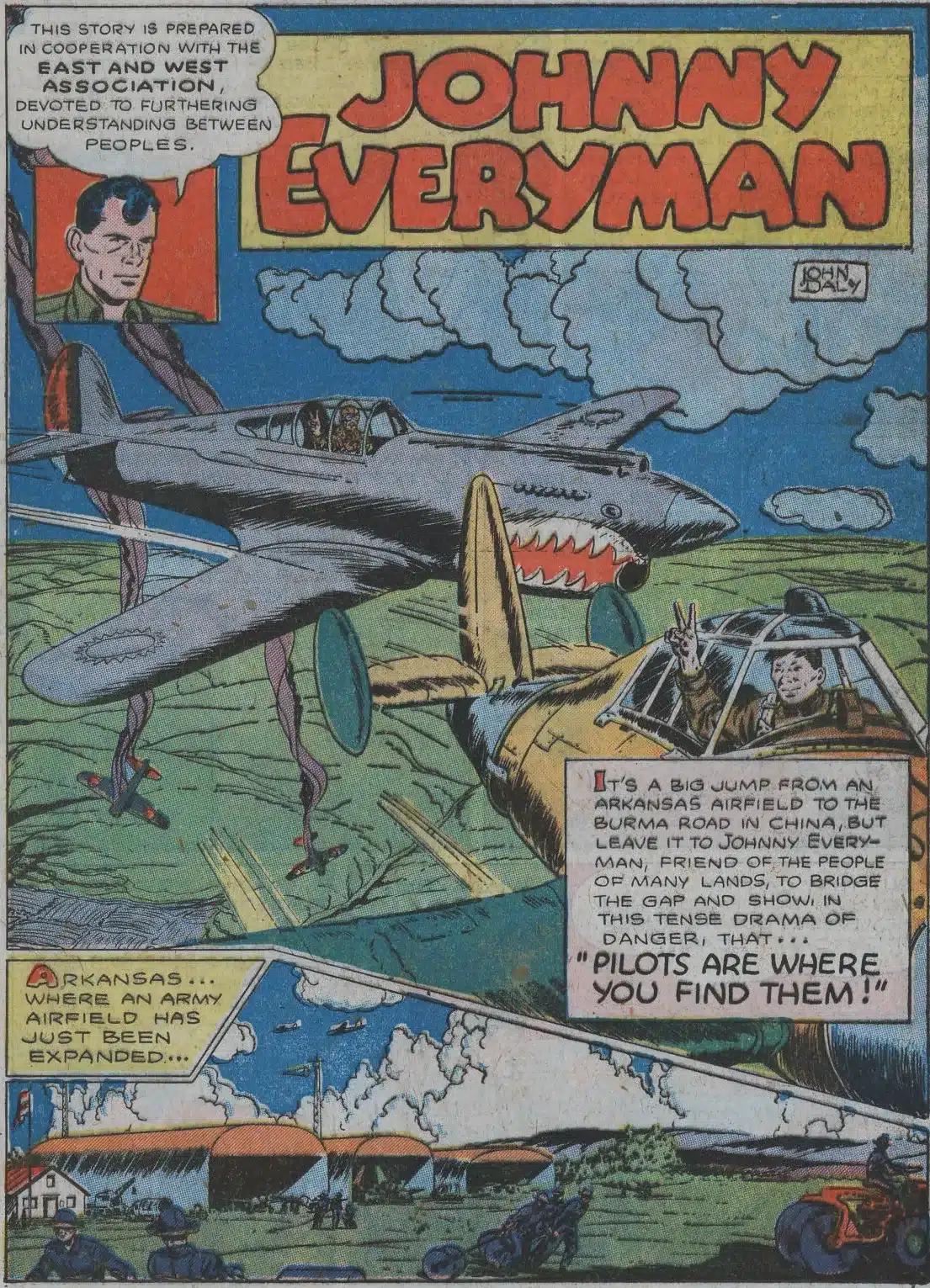
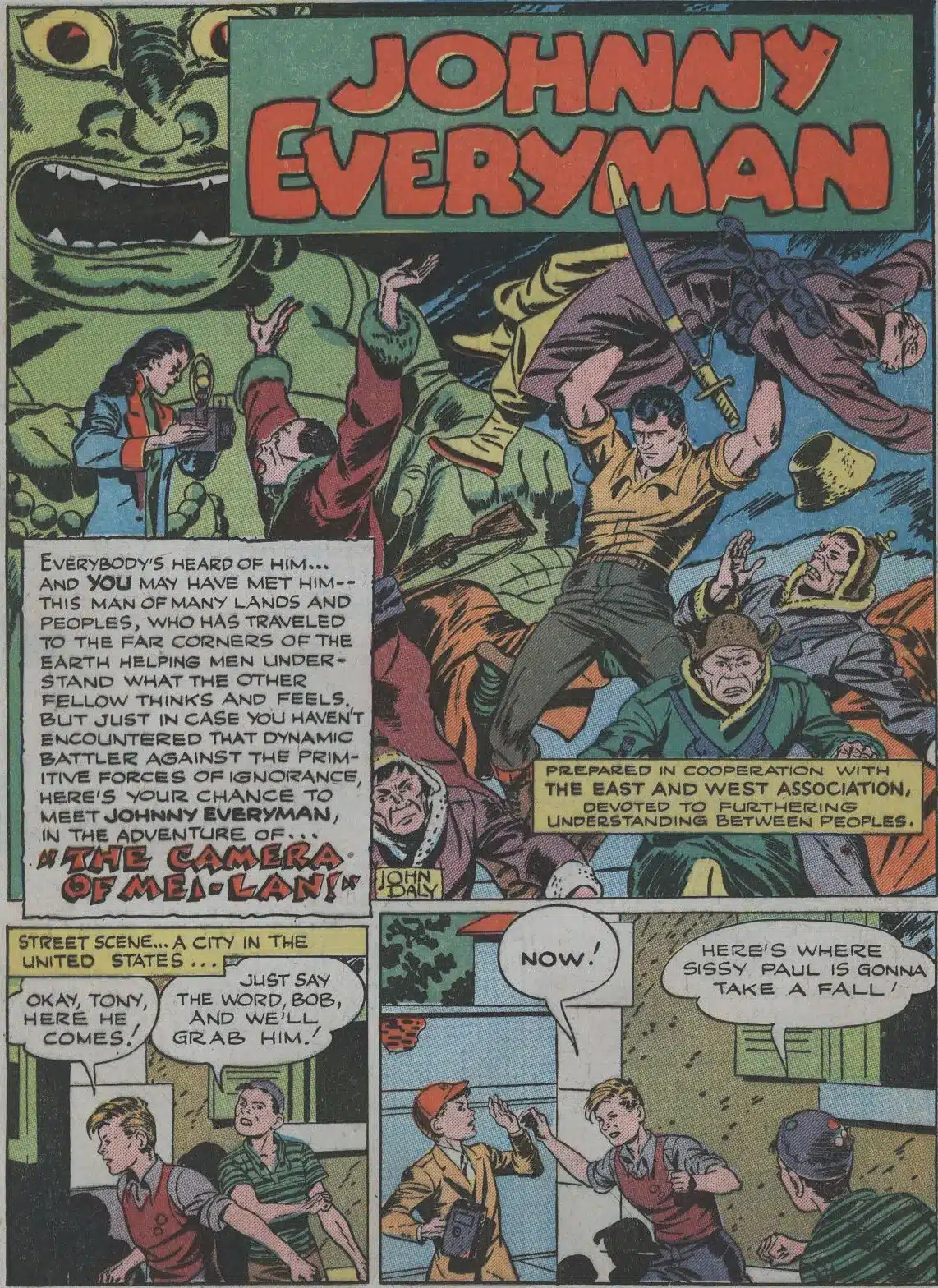

Timeline of Suspected Communist Affiliation According to the FBI File
January 1937
Pearl Buck was mentioned in the Daily Worker, a communist newspaper, as being a speaker at a banquet for the support of democracy in Spain. Many known communists and members of the Soviet government were expected to attend.
March 1942
Soviet Russia Today published Ms. Buck as a signatory on a letter from American women to Soviet women.
February 1943
The New York World Telegram published an article which charged that communists had taken complete control of the Japanese American Committee for Democracy. Pearl Buck was a member of the advisory board.
Searching through her mail, the Office of Censorship advised the Bureau that Ms. Buck received copies of a publication from Soviet Russia called Voks .This was the bulletin of the U.S.S.R. Society for Cultural Relations with Foreign Countries. This publication was related to her work with the East and West Association. Voks was known by the FBI as a cover group for Russian Intelligence.
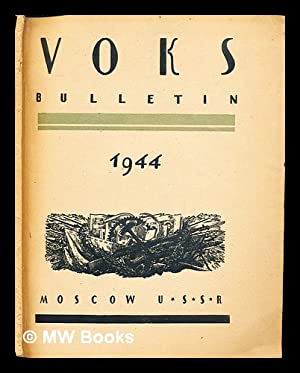
Pearl Buck was chairman of the Committee Against Racial Discrimination of the American Civil Liberties Union from 1943-1954. According to The Daily Worker their goal was to wipe out all race discrimination in the war effort. Ms. Buck sent a telegram to President Roosevelt in June 1943 calling for an FBI investigation on the “wave of mob violence against Negroes and other minority groups spread across the country.”
April 17, 1944
Pearl Buck attends known Communist and civil rights activist Paul Robeson’s 46th birthday party. Paul and his wife Eslanda Goode Robeson helped to found the Council on African Affairs, which the FBI deemed Communist controlled based on information from military intelligence.
March 21, 1946
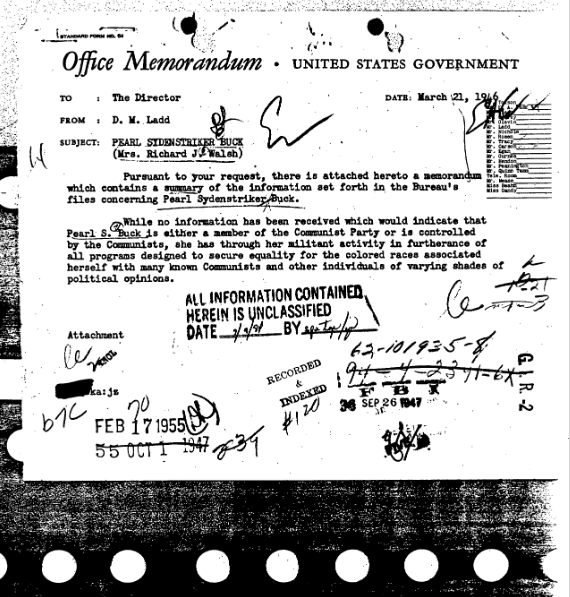
Memo to Director J. Edgar Hoover on Pearl S. Buck from Assistant to the Director D.M. Ladd
Read the Memo Here1949
Pearl Buck and Eslanda Goode Robeson, wife of Paul Robeson, publish the book American Argument.
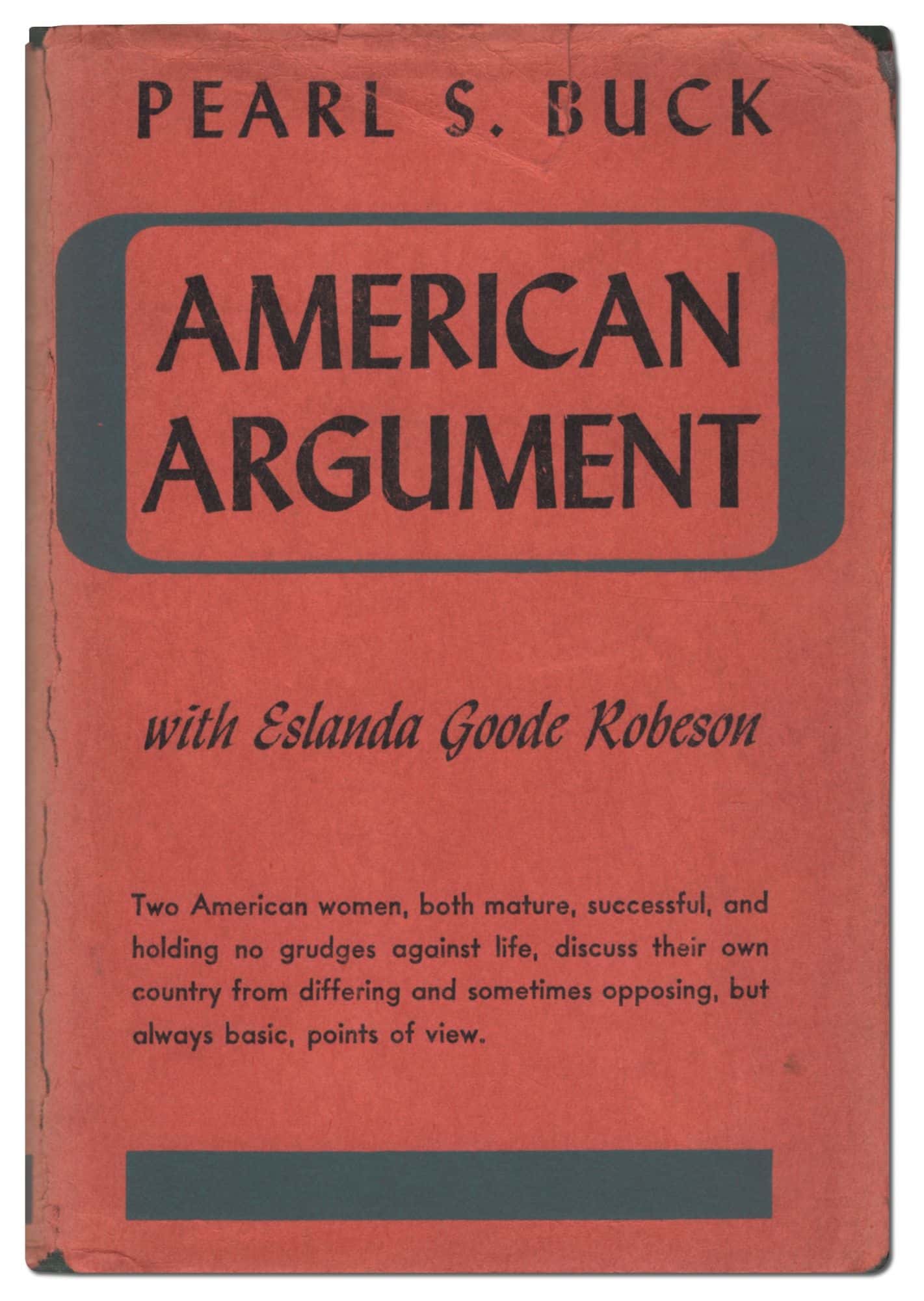
1950
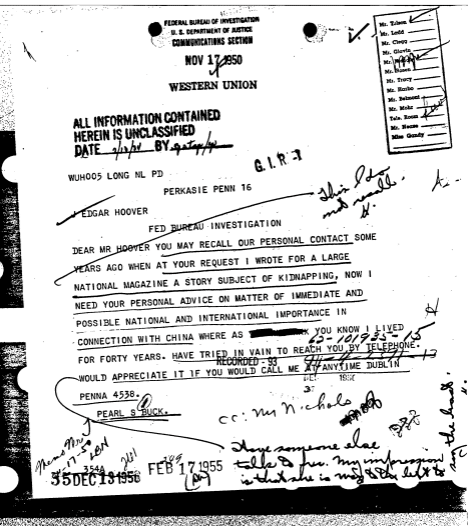
Telegram sent by Pearl Buck to FBI Director Hoover requesting a phone call of national and international importance in connection with China; Hoover wrote on the telegram, "Have someone else talk to her. My information is that she is way to the left to say the least. H." Director Hoover never spoke with her and denied ever corresponding with Pearl Buck.
Read the memo here1952

Memo to Director Hoover from Special Agent in Charge, Philadelphia, states that, “there is no evidence of membership in the Communist Party or other subversive organizations…No interview is contemplated at this time since it is felt that such an interview of a person of Miss Buck’s prominence might result in repercussions and adverse publicity for the Bureau.”
Read the Memo HereJanuary 1955
A high school teacher of American Literature wrote to Director Hoover about deep concerns over some reports and rumors concerning some of the authors being taught in schools. Pearl Buck was one of concern for Communist activity.
Spring 1955
Pearl Buck wrote a letter as part of a membership campaign on behalf of the Women’s International League for Peace and Freedom. This group opposed militarism and promoted world peace. One citizen reported the mailing to the FBI as the group was a suspected Communist front organization describing it as “dreadful.”
Pearl Buck and her husband Richard J. Walsh's longtime friend of over 20 years, Owen Lattimore, a professor at Johns Hopkins University, had worked in Asia all his life and was America’s leading expert on Mongolia. Senator McCarthy called Lattimore “the top Russian espionage agent in the United States.” He was blamed for the communist victory when he had accurately predicted Chiang Kai Shek’s defeat in China. In a letter released by the FBI to author Peter Conn for his biography of Pearl Buck, Ms. Buck and her husband wrote, “We are indignant and dismayed at [the] completely false charges against Owen Lattimore…The false charges are all the more unfortunate for the United States because this country needs the service of a man of his experience and wisdom. We urge immediate investigation of what persons and interests are behind this destructive attack.” The date and recipient of the letter were not disclosed.
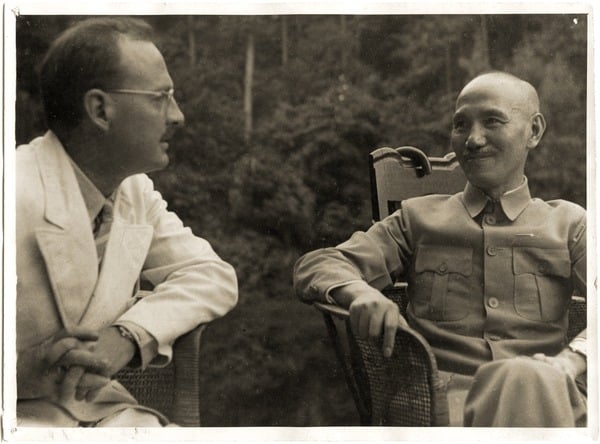
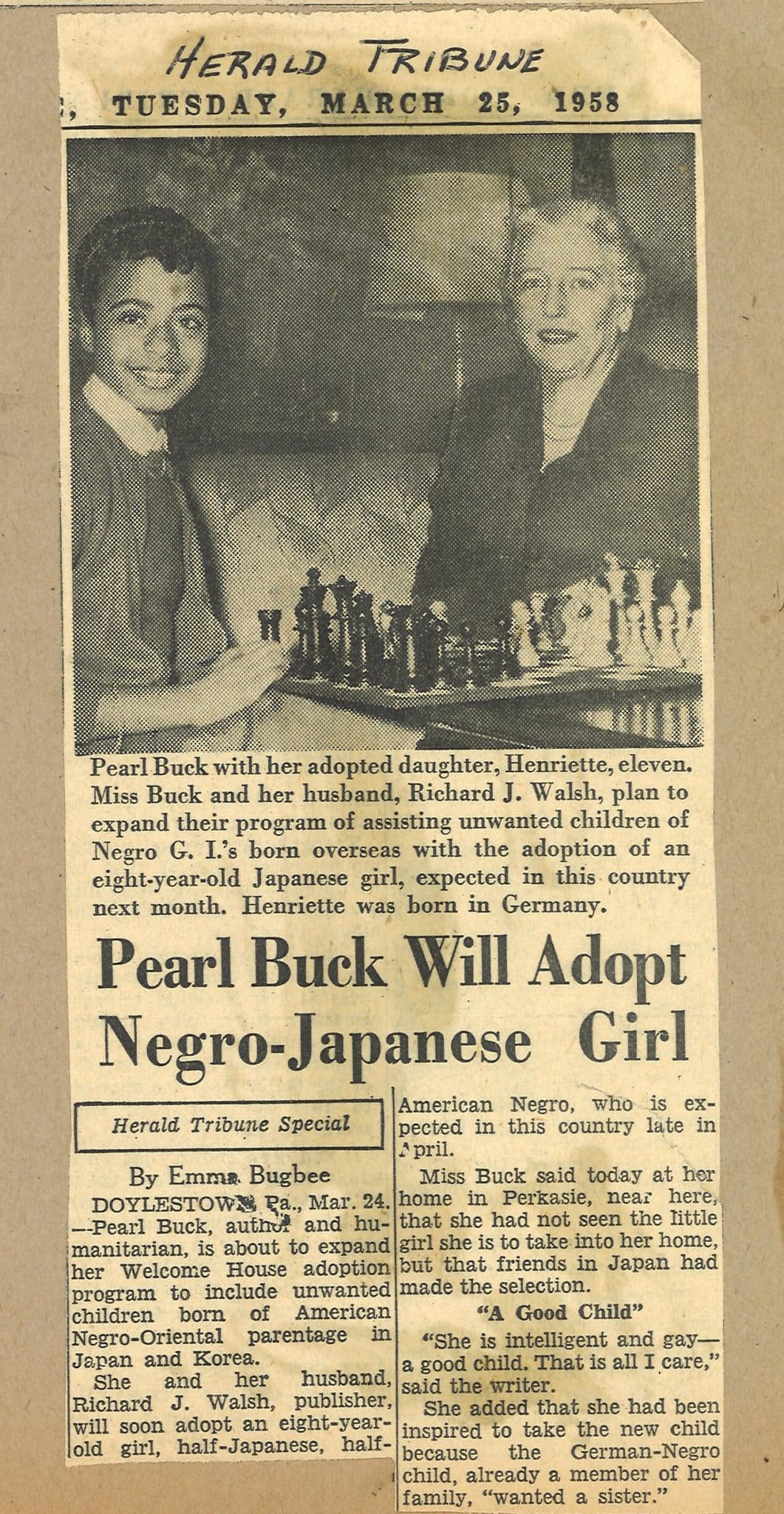
The FBI continues to follow Pearl Buck with no real evidence of communist ties. In 1958, she and her husband, Richard J. Walsh, adopted an eight-year-old child who was half Japanese and half African American. The Bureau included a clipping from the New York Herald Tribune about the adoption.
December 14, 1961
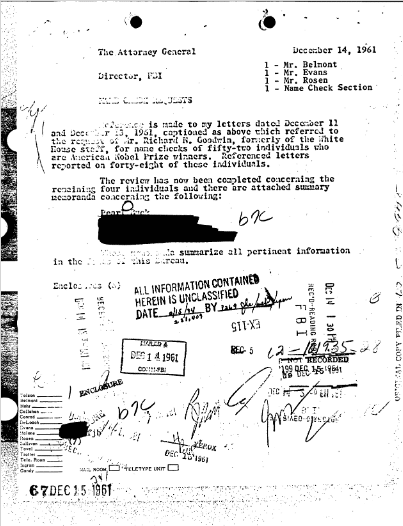
A memo was sent to the Attorney General from Director Hoover with the results of a name check request for the 52 individuals who were American Nobel Prize Winners. 48 individuals had files with the Bureau, one of which was Pearl Buck.
Read the memo hereDecember 14, 1961 continued
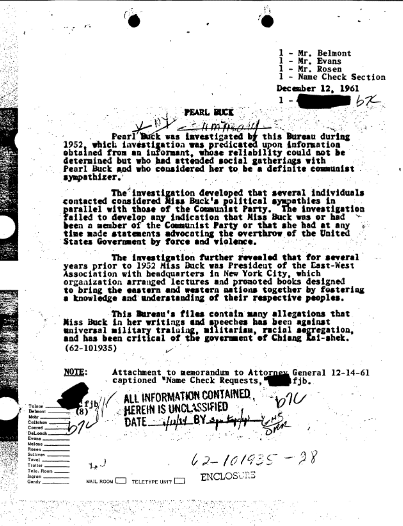
The enclosure on Ms. Buck discusses the investigations of her and also that the “Bureau’s files contain many allegations that Miss Buck in her writings and speeches has been against universal military training, militarism, racial segregation, and has been critical of the government of Chiang Kai-shek.”
April 1962
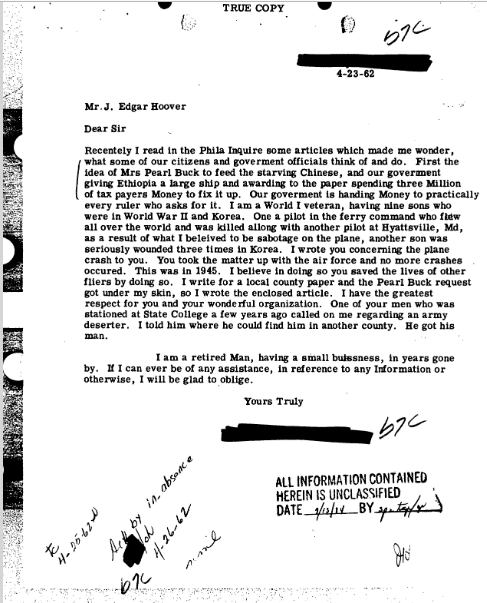
A letter from a concerned citizen and World War I veteran reached Hoover’s desk. His local paper published an appeal from Pearl Buck about food aid to China. In response he wrote to the Editor with his concerns.
August 1965
In August 1965, White House Staff Assistant Terrence M. Scanlon requested a name check on Pearl Buck for a possible presidential appointment. A letter was sent to Marvin Watson, Special Assistant to President Lyndon B. Johnson, detailing the previous Bureau investigations on Pearl Buck.
“The investigation failed to develop any indication that Miss Buck was or had a been a member of the Communist Party…”
Ms. Buck was being considered for the President’s Committee on Mental Retardation, a part time advisory group, later renamed the President’s Committee for People with Intellectual Disabilities (PCPID) in 2003.
This file is from the Lyndon B. Johnson Library and Museum, Office Files of John Macy.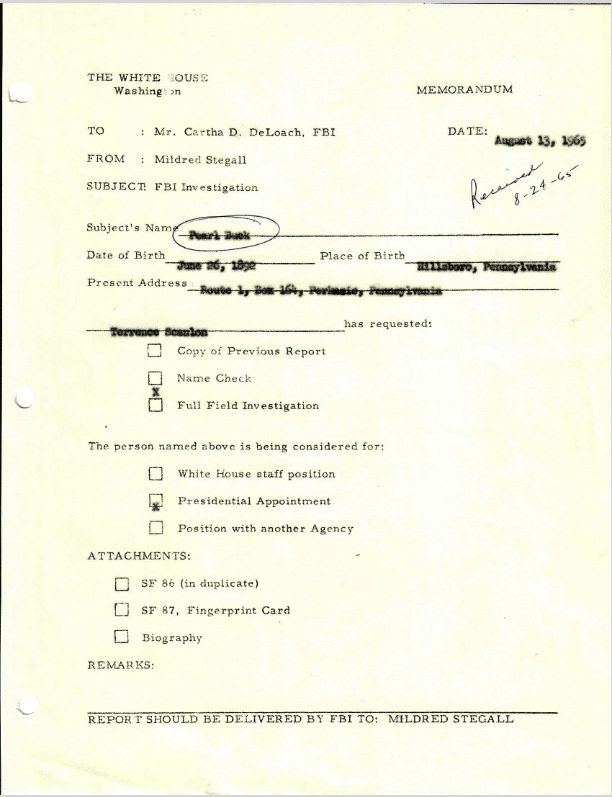
The FBI file was declassified starting in 1974 following the death of Pearl Buck the year prior. While the Bureau never formally interviewed her, their suspicions and concern about her influence on the public continued for over 30 years under the guise of fear of Communism. The last part of the FBI file contains letters and department memos detailing allegations made against unnamed employees of Ms. Buck’s non-profit the Pearl S. Buck Foundation. No formal investigation occurred. Documents removed from the file that remain classified are due to their national security implications and to protect personal privacy of individuals named.
To date, several parts of the Pearl Buck FBI file remain classified or heavily redacted.
“So impractical communism. I saw communism come in 1921 into China. We don’t realize it has been there so long and it's so impractical (laughs) it’s psychologically unsound and economically impossible….I think for anywhere…it’s a curious impossible impractical scheme of life.”
- Pearl Buck on The Merv Griffin Show, Sept. 21 1966
Resources and Further Reading
Buck, Pearl S File. Office Files of John Macy 1964-1965, Box 70, Lyndon B. Johnson Presidential Library.
Conn, Peter. Pearl S. Buck: A Cultural Biography. Cambridge Univ. Press, 1998.
Conn, Peter. “What the Remarkable Legacy of Pearl Buck Still Means for China.” The Atlantic Global. The Atlantic, August 9, 2012. https://www.theatlantic.com/international/archive/2012/08/what-the-remarkable-legacy-of-pearl-buck-still-means-for-china/260918/.
“FOIA/PA Overviews, Exemptions, and Terms.” FBI. FBI, July 18, 2016. https://www.fbi.gov/how-we-can-help-you/more-fbi-services-and-information/freedom-of-information-privacy-act/foia-pa-overviews-exemptions-and-terms.
Kwang, Thomas. Owen Lattimore and Chiang Kai-Shek, September 1941. W. L. Holland Papers (MS 782). Special Collections and University Archives, University of Massachusetts Amherst Libraries
Mitgang, Herbert. “Policing America's Writers.” The New Yorker, October 5, 1987. https://www.newyorker.com/magazine/1987/10/05/policing-americas-writers.
“Pearl S. Buck’s FBI File, 1938-1945”. The Space Between: Literature and Culture 1914–1945. Ed. Janine Utell. Special issue. International Intrigue: Plotting Espionage as Cultural Artifact. Phyllis Lassner and Will May, guest eds. 13 (2017).
“Pearl Buck.” FBI. FBI, December 6, 2010. https://vault.fbi.gov/Pearl%20Buck.

